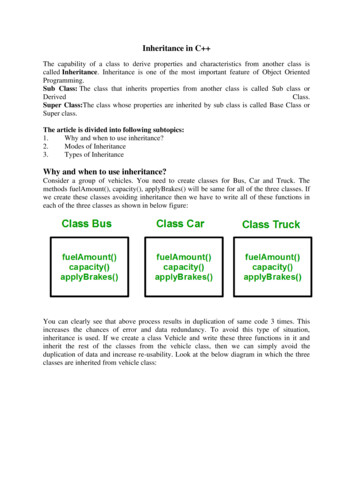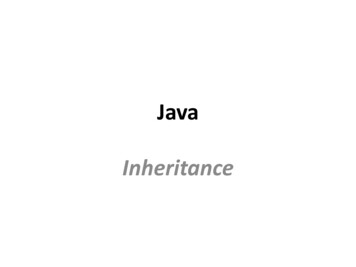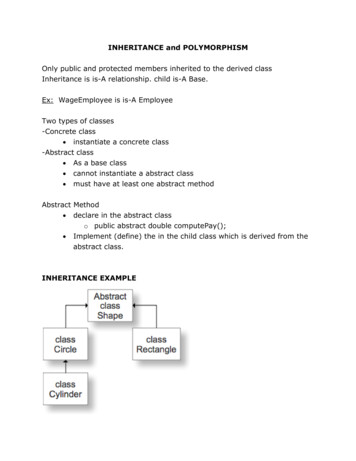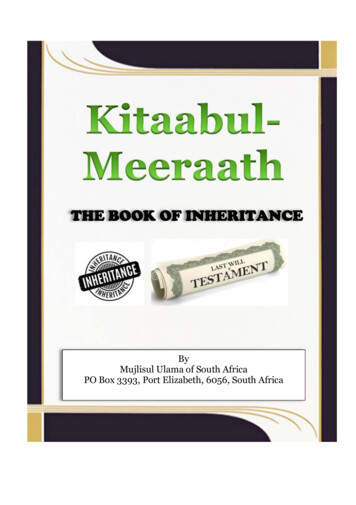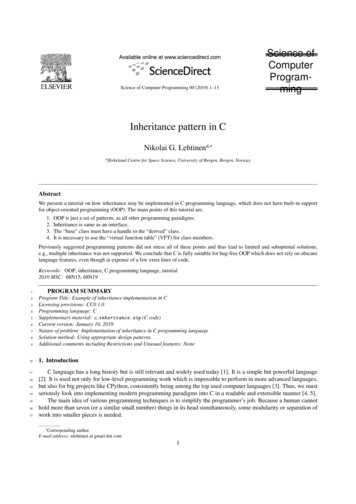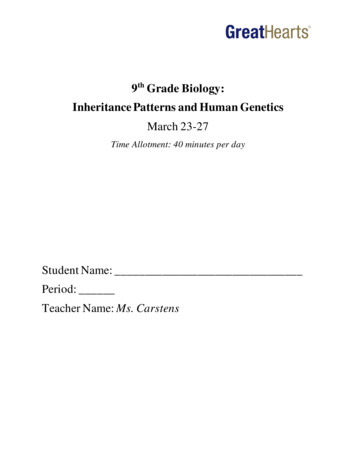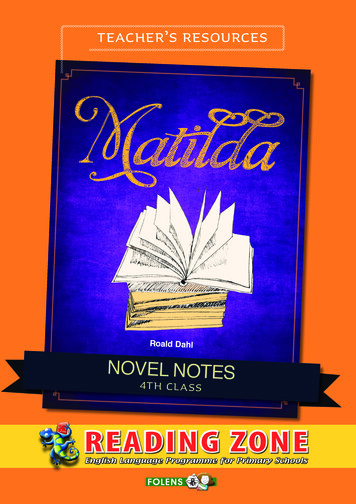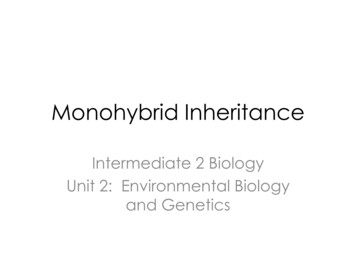
Transcription
Monohybrid InheritanceIntermediate 2 BiologyUnit 2: Environmental Biologyand Genetics
Inherited Characteristics Inherited characteristics are passed onfrom one generation to the nextthrough sexual reproduction Chromosomes are made up of genes Alleles are different forms of the samegene
Glossary Genotype– genes possessed by an organism Phenotype– physical appearance of an organism Homozygous– 2 identical alleles for a particular characteristic Heterozygous– 2 different alleles for a particular characteristic
Glossary Dominant– allele which controls thedevelopment of acharacteristic when it is presenton only one chromosome. Recessive– allele which control thedevelopment of acharacteristic if present onboth chromosomes.
Further definitions P – Parents F1 – first generation F2 – second generation
Genetics and symbols The dominant allele is given a capitalletter The recessive allele is given a lowercase letter In plants, tall is dominant to dwarf–T–t talldwarf
True-breeding An individual that is true-breeding hastwo identical alleles for thecharacteristic True breeding plants are homozygous In pea plants– TT is true-breeding tall plant– tt is a true breeding dwarf plant
Monohybrid Inheritance This is a genetic cross involving onlyone gene (characteristic)
A cross between a true breeding tall peaplant with a true-breeding dwarf pea plant.P phenotypeP genotypeGametesF1 genotypeF1 phenotype
Members of the F1 generationare self-pollinatedF1 phenotypeF1 genotypeGametesFertilisationF2 genotype ratioF2 phenotype ratio
Time to practice In pea plants, round is dominant towrinkled seeds. A cross was carriedout between a pea plant homozygousfor round seeds and a pea plant withwrinkled seeds. Carry out the cross through to the F2generation
In pea plants, round is dominant to wrinkled seeds. A cross wascarried out between a pea plant homozygous for round seedsand a pea plant with wrinkled seeds.P phenotypeP genotypeGametesF1 genotypeF1 phenotype
Members of the F1 generationare self-pollinatedF1 phenotypeF1 genotypeGametesFertilisationF2 genotype ratioF2 phenotype ratio
Monohybrid Inheritancepractice questions Remember to statesymbols used at start Lay out the cross usingheadingsP phenotypeP genotypeGametesF1 genotypeF1 phenotypeF1 self pollinatedF1 phenotypeF1 genotypeGametesFertilisationF2 genotype ratioF2 phenotype ratio
Polygenic inheritance This is inheritance when thecharacteristic is controlled by morethan one gene– eye colour in humans– Seed mass in pea plants
Predicting number of offspring A monohybrid cross between two truebreeding parents will always producea 3:1 phenotype ratio in the F2generation. Often there is a difference betweenobserved and expected results due tofertilisation being a random processwhich involves the element of chance.
Using a bead model to illustratea monohybrid cross This model represents self-pollination ofthe F1 generation of pea plants followinga cross between a true-breeding peaplant with lilac flowers and a whiteflowered pea plant. You will be provided with two beakerscontaining 100 lilac beads and 100 whitebeads– These are to represent heterozygous lilacflowered pea plants
Using a bead model to illustratea monohybrid cross Collect three beakers labelled LL, Lland ll Use the “gamete” beads to form andclassify “zygotes” Record your results as a tally mark forthe three genotypes Express your results as a F2 phenotypicratio.
Crossnumber4102550100LLLlllratio
Human Inheritance A family treecan be usedto trace aparticular traitthroughseveralgenerations.
Working out genotypes using afamily tree Let T tongue rolling ability Let t inability to roll tongue
Co-dominance Co-dominant alleles are bothexpressed in the phenotype of aheterozygous organism. E.g. Flower colour– RR red– Rr pink– Rr white This co-dominant cross would give a1:2:1 phenotype ratio
Human Blood Groups There are three alleles for humanblood groups– IA– IB– Io– IA and IB are co-dominant– Io is recessive
Human Blood GroupsgenotypeIA IAIA IoIB IBIBIoIA IBIo IoBlood GroupPhenotypeAABBABo
Environmental impact onphenotype Phenotype is a result of interactionbetween– the genotype– the effect of the environment on growth anddevelopment. Some characters are unaffected byenvironmental factors– Tongue rolling ability– ABO blood groups
Same genotype, differentphenotypes Identical twins in humans– A twin fed a poorer diet will fail to reach fullpotential height Clones in plants (asexual reproduction)– Arrowhead plant (pg193) Differences caused by environmentalfactors are not passed on to nextgeneration
evolution Two scientists, two theories– Acquired characteristics – Lamark– Natural Selection - Darwin
Natural selection Variation Over-production– All species of organisms has a largereproductive potential Struggle for survival– The environment can not support alloffspring and this leads to competition
Survival of the fittest Offspring whosephenotypes arebetter adapted totheir environmenthave a betterchance of surviving– Pass on genes totheir offspring Offspring whosephenotype are lesswell-suited toenvironment diebefore reachingreproductive age– Fail to pass on genes
Charles Darwin Observation 1:– Living things have the potential to producemore offspring than are needed to replacethem. Observation 2:– The number of organisms in the wild,however, usually remains the same. Deduction:– Darwin deduced that some organisms mustdie before they reproduce.
Observation 3:– Most living things show variation. No two individualsare usually alike. Deduction:– Darwin concluded that the organisms which survivedwere the best adapted or ‘fittest’ Observation 4:– Some types of variation are passed on from parentsto their offspring. Deduction:– Populations will slowly change or ‘evolve’ assuccessful parents pass on characteristics to theiroffspring.
Natural Selection in Action Peppered Moth– Two forms Light brown with speckles Melanic (dark) form– Both forms flay at night and rest on treetrunks during the day
Peppered moth“A modern example of evolution”Pale coloured, speckled peppered moth
Peppered moth“A modern example of evolution”Dark coloured peppered moth
Peppered moth“A modern example of evolution”Peppered moths on tree trunk
In non-polluted areas, tree trunks arecovered with lichens, the light form iswell camouflaged against thebackground. In polluted areas, toxic gases kill thelichens and soot particles darken thetrunks. The melanic (dark) form isfavoured by natural selection.
Natural Selection in ActionActivity You will be given two different colours of punched paper– Spread out 50 discs of each colour onto to the sheet of A3 paper Start the stopwatch/ stopclock and time one minute.– During this time, use the forceps to pick out as many paper discsas possible– Place the paper discs in a Petri dish. Count how many paper discs of each colour you haveremoved. If the total number is an odd number, pick out one more grain. Add more paper discs the paper to make it up to 100 again,by adding equal numbers of each colour. Make a note ofhow many grains there are of each colour now. Theproportion of the two colours will now be different.
Time another minute and pick out asmany paper discs as possible. Repeat this 4 more times Repeat the whole activity on a sheetof news paper
Trial one – on white paperNumber of discsremovedwhitenewspaperAt start1st pick2nd pick3rd pick4th pick5th pickNumber of discsreplacedwhitenewspaperPercentage of discs ineach colourwhitenewspaper
Trial one – on news paperNumber of discsremovedwhitenewspaperAt start1st pick2nd pick3rd pick4th pick5th pickNumber of discsreplacedwhitenewspaperPercentage of discs ineach colourwhitenewspaper
Monohybrid Inheritance This is a genetic cross involving only one gene (characteristic) A cross between a true breeding tall pea plant with a true-breeding dwarf pea plant. P phenotype P genotype Gametes F 1 genotype F 1 phenotype . Members of the F 1

